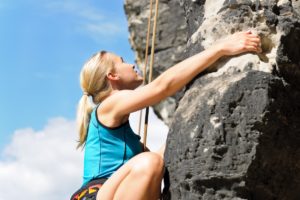 Finger injuries are one of the most common injuries sustained by climbers, due to the huge forces required to pull the body weight up. After spending much time in the climbing community and treating many climbers, I am all too aware of the impact a ‘minor’ finger injury can have on your training and climbing experience.
Finger injuries are one of the most common injuries sustained by climbers, due to the huge forces required to pull the body weight up. After spending much time in the climbing community and treating many climbers, I am all too aware of the impact a ‘minor’ finger injury can have on your training and climbing experience.
Most commonly injured are the finger pulleys. These are ligaments (called annular ligments or pulleys), and their role is to hold the tendons close to the bone as they bend the finger, therefore acting as a pulley. The tendons attach to the Flexor Digitorum Superficialis (FDS) muscle and the Flexor Digitorum Profundus (FDP) muscle.
The A2 pulley, which sits just at the base of your finger, is the site of most injuries. This is the pulley where the most force is generated when you pull hard on a small climbing hold – also known as ‘crimping’. Symptoms include pain and swelling and, if there is a complete rupture, there may be an audible pop at the time of injury.
Finger tendons can also become inflamed from over-climbing. This is called tendonitis. Symptoms generally come on more gradually, but could also be sudden as with a rupture of the tendon or an avulsion fracture (where a small piece of bone is pulled off with the tendon).
If you suffer from any finger issues when climbing, don’t ignore it, as generally it won’t just go away! It is advisable to get it checked out quickly, as left untreated it may become worse and take a longer time to recover.






Hi there,
I came across your article via Google today. I’m looking for some advice on rehabing an A1 tendon pulley rupture. I’d also love some advice on proper taping- it’s a difficult joint to tape! Thank you for this website!
Warmly,
Angelina Swanson
Bend, Oregon
Hi Angelina,
Thanks for the comment, it’s good to see people reading our physio blogs.
Pulley injuries can be pretty nasty and, if not rested, minor sprains can turn into ruptures and further pulley damage up the finger, so rest while painful is the most important part of the rehab process. I’m not sure the full extent of your injury to make a call, so it’s best to see someone and make sure it is what it is. If it’s still fairly acute, ice and a degree of immobilisation is helpful, however it is recommended you do some gentle finger movements (using the other hand to start with, progressing to more active movements as tolerated) so the finger doesn’t stiffen. The long finger flexors are prone to adhering to their sheaths on occasion. During this time it’s best to avoid loaded finger flexion and definitely no crimp holds on the first few times back once it’s settled. If it doesn’t settle and you suspect a full rupture, you’re going to have to see a hand specialist – therapist or surgeon (not sure how it works over there in the US).
As for taping, there are some suggestions out on the net about circumferential taping (i.e. around the finger) to replicate the pulley, but the tension required to actually achieve that is probably more than the finger can handle. Buddy taping or a tape to prevent any finger movement would be slightly helpful, but at the end of the day, it’s a bit of a safety blanket, and you would hope to have a strong, healed pulley before you go back climbing.
In summary: rest, see someone and don’t rely too much on tape.
Hope this helps!